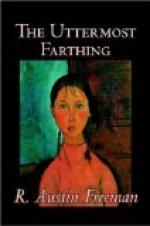“This latter I proceeded with at once. To the end of a rod of rhinoceros horn about two feet long I affixed a knob of lead weighing two pounds. I covered the knob with a thickish layer of plaited horsehair, and over this fastened a covering of stout leather; and when I had fitted it with a wrist-strap it looked a really serviceable tool. Its purpose is obvious. It was an improved form of that very crude appliance, the sand-bag, which footpads use to produce concussion of the brain without fracturing the skull. I may describe it as a concussor.
“The preliminary measures were proceeding steadily. I had put in a fortnight’s attendance at a gymnasium under the supervision of Professor Schneipp, the Bavarian Hercules; I had practiced the most approved ‘knock-outs’ known to my instructor, the famous pugilist, Melchizedeck Cohen (popularly known as ‘Slimy’ Cohen); I had given up an hour a day to studying the management of the concussor with the aid of a punching-ball; the alarms were ready for fixing, and I even had the address of an undoubtedly disreputable housemaid, when a most unexpected thing happened. I got a premature bite. A fellow actually walked into the trap without troubling me to set it.
“It befell thus. I had gone to bed rather early and fallen asleep at once, but about one o’clock I awoke with that unmistakable completeness that heralds a sleepless night. I lit my candle-lamp and looked round for the book that I had been reading in the evening, and then I remembered that I had left it in the museum. Now that book had interested me deeply. It contained the only lucid description that I had met with of the Mundurucu Indians and their curious method of preserving the severed heads of their enemies; a method by which the head—after removal of the bones—was shrunk until it was no larger than a man’s fist.
“I got up, and, taking my lamp and keys, made my way to the museum wing of the house, which opened out of the dining-room. I found the book, but, instead of returning immediately, lingered in the museum, looking about the great room and at the unfinished collection and gloomily recalling its associations. The museum was a gift from my wife. She had built it and the big laboratory soon after we were married and many a delightful hour we had spent in it together, arranging the new specimens in the cases. I did not allow her to work in the evil-smelling laboratory, but she had a collection of her own, of land and fresh-water shells (which were cleaner to handle than the bones); and I was pulling out some of the drawers in her cabinet, and, as I looked over the shells, thinking of the happy days when we rambled by the riverside or over furzy commons in search of them, when I became aware of faint sounds of movement from the direction of the dining-room.
“I stepped lightly down the corridor that led to the dining-room and listened. The door of communication was shut, but through it I could distinctly hear someone moving about and could occasionally detect the chink of metal. I ran back to the museum—my felt-soled bedroom slippers made no sound—and, taking the ‘concussor’ from the drawer in which I had concealed it, thrust it through the waist-band of my pajamas. Then I crept back to the door.




